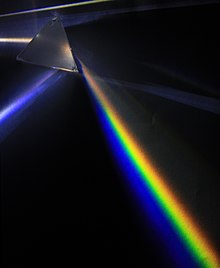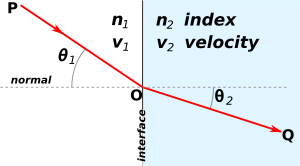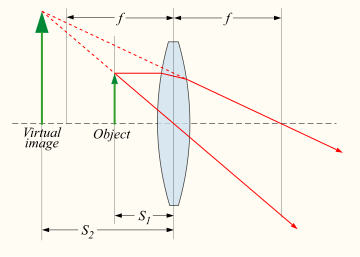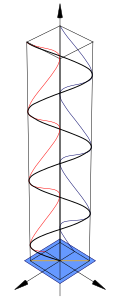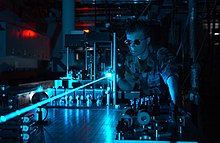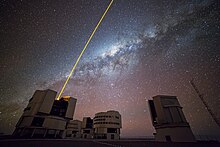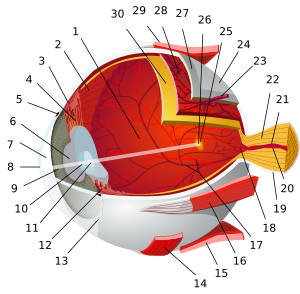Optics
Optics (from the medieval Latin opticus, «related to vision», from the ancient Greek ὀπτικός, optikós) is the branch of physics that deals with the study of the behavior and properties of light, including its interactions with matter, as well as the construction of instruments that use or detect it. Optics generally describes the behavior of visible light, ultraviolet radiation, and infrared radiation. Being an electromagnetic radiation, other forms of radiation of the same type such as X-rays, microwaves and radio waves show similar properties.
Most optical phenomena can be explained using the classical electrodynamic description of light. However, practical optics generally uses simplified models. The most common of these models, geometric optics, treats light as a collection of rays that travel in straight lines and bend when they pass through or are reflected from surfaces. Physical optics is a more complete model of light, including wave effects such as diffraction and interference, which cannot be addressed by geometric optics.
Some phenomena depend on the fact that light exhibits properties like wave and particle interchangeably. The explanation of these effects requires going to quantum mechanics. By considering the particle-like properties of light, it can be modeled as a collection of individual photons. Quantum optics deals with the application of quantum mechanics to optical systems.
Optics as a science is a very relevant field, and is studied in many disciplines with which it is closely related, such as astronomy, various fields of engineering, photography, and medicine (particularly ophthalmology and optometry). Practical applications of optics are found in a wide variety of technologies, including mirrors, lenses, telescopes, microscopes, laser equipment, and fiber optic systems.
History
The first applications of optics most likely began with the development of lenses in ancient Egypt and Mesopotamia. The earliest known lenses, made of polished glass, often quartz, date as early as 700 BC. C., like the Nimrud lens, discovered in Assyria. Water-filled glass spheres used as lenses in ancient Rome and ancient Greece are also known. The invention of these objects was followed by the emergence of theories of light and vision put forward by ancient Greek and Indian philosophers, and by the development of geometric optics in the Greco-Roman world. The word optics comes from the Greek word ὀπτική (optikē), which means "aspect, appearance".
Greek philosophy of optics split into two opposing ideas about how sight worked: the "theory of vision" and the "emission theory".
The first approach considered that vision came from the objects themselves. According to the Aristotelian theory of vision, sensations are carried out through a medium, such as air or water. These are transparent, in terms of possibility or power. The transparency update is light; this is therefore a state of the transparent as such rather than a movement, and its appearance is instantaneous. Aristotle believed that light was a kind of disturbance in the air. However, according to Aristotle, light does not travel or move, but rather is a presence that pervades space. Atomists such as Democritus, Epicurus, and their followers held that objects that emitted images of themselves (called eidola ) that were captured by the eye.
Plato was the first to articulate the emission theory, the idea that vision is achieved by rays emitted from the eyes. He also discussed inversion in mirrors (of the parity between an object and its reflected image) in the Timaeus. About a hundred years later, Euclid wrote a treatise entitled Optics, where he linked vision to geometry, creating geometrical optics. In his work on Plato's theory of emission he described the mathematical rules of perspective and described the effects of refraction qualitatively, although questioned that a beam of light emitted from one eye would instantly illuminate the stars whenever someone blinked.
Claudio Ptolemy, in his treatise on Optics, introduced a theory of vision that combined the two previous ones: the rays (or the flux emitted) from the eye formed a cone, the vertex was inside the eye and the base defined the visual field. The rays were sensitive and conveyed information to the observer's intellect about the distance and orientation of surfaces. He summarized much of Euclid's work and described a way to measure the effects of Snell's law, although he did not realize the empirical relationship between the angles.
During the Middle Ages, Greek ideas about optics were revived and expanded upon by various writers in the Islamic world. One of the first was Al-Kindi (c 801-73), who wrote on the merits of Aristotelian and Euclidean ideas of optics, favoring the theory of emission as it could better quantify optical phenomena. In 984, Iranian mathematician Ibn Sahl wrote the treatise 'On Incendiary Mirrors and Lenses', correctly describing a law of refraction equivalent to Snell's law. He used this law to calculate optimal shapes for curved mirrors and lenses. At the beginning of the s. XI d. C., Alhacén, considered one of the fathers of optics, wrote the Optics Book (Kitab al-manazir) in which he explored reflection and refraction and he proposed a new system to explain vision and light based on observation and experimentation. He rejected the "emission theory" of Ptolemaic optics with its rays emitted by the eye, and put forward the idea that light is reflected in all directions in straight lines from all points on objects viewed and then enters the eye, although he was not able to explain correctly how the eye caught the rays. Alhacen's work was largely ignored in the Arab world, but it was anonymously translated into Latin around 1200 and later summarized and expanded by the Polish monk Witelo, becoming a text standard on optics in Europe for the next 400 years.
In medieval Europe in the 13th century century, English Bishop Robert Grosseteste wrote on a wide range of scientific topics and discussed light from four different perspectives: an epistemology of light, a metaphysics or cosmogony of light, an etiology or physics of light, and a theology of light, drawing on the works of Aristotle and Platonism. Grosseteste's most famous disciple, Roger Bacon, wrote works citing a wide range of optical and philosophical works then translated, including those of Alhazen, Aristotle, Avicenna, Averroes, Euclid, al-Kindi, Ptolemy, Tideus, and Constantine the African.. Bacon was able to use parts of glass spheres as magnifying glasses to show that light reflects off objects rather than being released from them.
The first practical eyeglasses were invented in Italy around 1286. This was the beginning of the optical industry of lens grinding for these eyepieces, first in Venice and Florence in the 18th century XIII, and later at eyeglass manufacturing centers in the Netherlands and Germany. Eyeglass manufacturers created improved types of lenses for vision correction, based more on empirical knowledge gained from observing the effects of lenses than using the rudimentary optical theory of the time (a theory that couldn't even adequately explain how glasses worked). Experimentation with lenses led directly to the invention of the compound optical microscope around 1595 and the refracting telescope in 1608. Both appeared in the centers of spectacle manufacturing in the Netherlands.
Around the year 1600, Galileo Galilei directed his primitive refracting telescope towards the firmament, giving rise to modern astronomy, which could use magnifying instruments to see the details of celestial bodies. Following in his wake, in the early 17th century Johannes Kepler expanded geometric optics in his writings, covering lenses, reflections of flat and curved mirrors, the principles of the pinhole camera, the inverse square laws governing the intensity of light, and optical explanations of astronomical phenomena such as lunar and solar eclipses and astronomical parallax. He was also able to correctly deduce the role of the retina as the actual image-perceiving organ, and was eventually able to scientifically quantify the effects of the different types of lenses that eyeglass manufacturers had been looking at for the past 300 years. After the telescope was invented, Kepler laid the theoretical foundation for how it worked and described an improved version, known as the Keplerian telescope, using two convex lenses to produce higher magnification.
Optical theory progressed in the mid-17th century with treatises written by the philosopher René Descartes, in which he explained a wide variety of optical phenomena, including reflection and refraction by assuming that light was emitted by the objects that produced it. This interpretation differed substantially from the ancient Greek theory of emission. In the late 1660s and early 1670s, Isaac Newton expanded Descartes's ideas into a corpuscular theory of light, determining that white light was a mixture of colors that can be separated into its component parts with a prism. In 1690, Christiaan Huygens proposed a wave explanation for light, building on suggestions Robert Hooke had made in 1664. Hooke himself publicly criticized Newton's theories of light, and the dispute between the two lasted until Hooke's death. In 1704, Newton published Opticks and, at the time, partly because of his success in other areas of physics, he was generally considered the victor in the debate over the nature of light.
Meanwhile, optical instruments began to undergo considerable technical improvements, allowing science to delve into hitherto inaccessible fields, from the extremely small (as represented by the discovery of microbes) to the inconceivably large (with ever-increasing knowledge). largest in the solar system). The microscope, considerably evolved from the primitive model of Anton van Leeuwenhoek (1650), allowed the study of cells to begin thanks to the pioneering work of Robert Hooke, collected in his treatise Micrographia. On the other hand, refracting telescopes had reached their theoretical limit of resolution, limited by chromatic aberration, which in part contributed to the birth of a new type of instrument: the reflecting telescope. It was Isaac Newton who built the first of these instruments in 1668. This was the beginning of a bitter race, which lasted two and a half centuries, between the two types of telescopes: refractors (lenses) and reflectors (mirrors). The invention of achromatic lenses around 1750 allowed solving the problem of chromatic aberration, which initially gave primacy to refracting telescopes over primitive reflecting telescopes, weighed down by low luminance and poor durability of speculum mirrors, a bronze alloy that oxidized relatively easily. The foundations for the development of large refractors were laid at this time, which with Joseph von Fraunhofer reached their functional maturity at the end of the 18th century, becoming the dominant technique in the 19th century. It was also Fraunhofer who would lay the foundations for a new science that is part of optics: spectroscopy. The advances in the manufacture of lenses allowed the development of the instruments used in geodesy, allowing the measurement of the arc of the meridian of Paris in 1798 to be completed with a precision hitherto unthinkable, which would allow the establishment of the unit of length of the international system.: the subway.
Newtonian optics was generally accepted until the early 19th century, when Thomas Young and Augustin Fresnel carried out experiments on the interference of light, which firmly established its wave nature. Young's famous double-slit experiment, which revealed the phenomenon of interference, demonstrated that light followed the principle of layer superposition, which is a wave property not anticipated by Newton's corpuscular theory. This work led to a theory of the diffraction of light and opened up a whole area of study in physical optics. Wave optics was successfully unified with electromagnetism by James Clerk Maxwell in the 1860s.
The second half of the 19th century saw a series of discoveries that would lay the foundations for the development of optical instruments throughout XX century. In the field of telescopes, the possibility of depositing an aluminum film on a glass base definitively settled the race between the two types of telescopes, deciding in favor of those with mirrors, which have continued to increase in size without cease since then. Likewise, the basis of photography was discovered with the works of Niépce, which in turn would lead to the appearance of cinema a few decades later. Another invention from the end of the XIX century, the cathode ray tube, would make it possible to develop television screens a few years later. Another type of scientific instrument also saw the light of day in this period, the interferometer, which served to give unexpected support to the theory of relativity and which, over time, has become part of extremely high-precision measurement equipment, such as LIGO, which confirmed the existence of gravitational waves at the beginning of the XXI century.
The apparent confirmation of the wave nature of light due to its character of electromagnetic radiation, led to a dead end, generating an intense debate over half a century about the existence of the ether, a hypothetical medium that was considered essential to enable the propagation of light waves. Numerous experiments were carried out without success to prove its existence (such as the famous Michelson and Morley experiment of 1887), and it would not be until 1905 when Albert Einstein, with his Theory of Special Relativity, established the key role of the speed of light. as one of the fundamental constants of nature, resolving once and for all the question of the ether, definitively ruling out its existence.
The next development in optical theory came in 1899, when Max Planck correctly modeled blackbody radiation, by assuming that the energy exchange between light and matter only occurred in discrete quantities that he called quanta. In 1905 Albert Einstein published the theory of the photoelectric effect which firmly established the quantization of light itself. In 1913 Niels Bohr showed that atoms could only emit discrete amounts of energy, which explains the lines observed in the emission and absorption spectra. The understanding of the interaction between light and matter that followed these developments not only formed the basis of quantum optics, but was also crucial to the development of quantum mechanics. as a whole. The latest culmination, the quantum electrodynamic theory, explains all optical and electromagnetic processes in general as a result of the exchange of real particles and virtual photons.
Quantum optics gained practical importance with the inventions of the maser in 1953 and the laser in 1960. Following the work of Paul Dirac in quantum field theory, George Sudarshan, Roy Jay Glauber, and Leonard Mandel applied quantum theory to electromagnetic field in the 1950s and 1960s to gain a more detailed understanding of photodetection and the statistical behavior of light.
Another important milestone in the field of practical application of optical devices are LEDs, whose operating principle (electroluminescence) was discovered in 1903. They began to be produced industrially in the 1950s, until they became ubiquitous on screens of all kinds of mass consumption devices, such as mobile phones or televisions.
Classical optics
Classical optics is divided into two main branches: geometric (or ray) optics and physical (or wave) optics. In geometric optics, light is considered to travel in a straight line, while in physical optics, light is considered to be an electromagnetic wave.
Geometric optics
Geometric optics can be viewed as an approximation to physical optics that applies when the wavelength of light used is much smaller than the size of the optical elements in the system being analyzed. geometrical optics, or ray optics, describes the propagation of light in terms of “rays” that travel in straight lines, and whose paths are governed by the laws of reflection and refraction in phase changes between different media. These empirically discovered laws have been widely used in the design of optical components and instruments.
The laws of reflection and refraction can be derived from Fermat's principle, which states that "the path traveled between two points by a ray of light is the path that can be traversed in the shortest possible time."
Approaches
Geometric optics is often simplified by doing a paraxial approximation or "small angle approximation". Mathematical behavior becomes linear, allowing optical components and systems to be described by simple matrices. This leads to the techniques of Gaussian optics and paraxial ray tracing, which are used to determine the basic properties of optical systems, such as the approximate images and positions of objects and the corresponding optical magnification.
Reflection
Reflection can be divided into two types: mirror image and diffuse reflection. Specular reflection describes the shine of surfaces such as mirrors, which reflect light in a simple and predictable way. This allows the production of mirror images that can be associated with an actual (real) or extrapolated (virtual) location in space. Diffuse reflection describes non-glossy materials, such as paper or rocks. Reflections from these surfaces can only be described statistically, with the exact distribution of reflected light depending on the microscopic structure of the material. Many diffuse reflectors are described or can be approximated by Lambert's law, which describes surfaces that have equal luminance when viewed from any angle. Glossy surfaces can give both a specular and diffuse reflection.
In specular reflection, the direction of the reflected ray is determined by the angle that the incident ray makes with the normal vector, a line perpendicular to the surface at the point where the ray strikes. The incident and reflected rays and the normal lie in a single plane, and the angle between the reflected ray and the surface normal is the same as that between the incident ray and the normal. This physical phenomenon is known as a mirror image.
For plane mirrors, the law of reflection implies that the images of the objects are upright and the same distance behind the mirror as the objects in front of the mirror. The size of the image is the same as the size of the object. The law also implies that mirror images exhibit a reversed parity, which is perceived as a left-right inversion. Images formed from reflection in two (or any even number of) mirrors do not exhibit reverse parity. A corner reflector is a retroreflector that produces reflected rays that travel in the same direction (and a different direction) from which the incident rays came.
Curved mirrors can be rendered using ray tracing and using the law of reflection at each point on the surface. In parabolic mirrors, rays parallel to the axis incident on the mirror produce reflected rays that converge to a common focus. Other curved surfaces can also focus light, but with aberrations due to the diverging shape that causes the focus to spread out in space. In particular, spherical mirrors exhibit spherical aberration. Curved mirrors can form images with a magnification greater or less than one, and the magnification can be negative, indicating that the image is inverted. A vertical image formed by reflection in a mirror is always virtual, while an inverted image is real and can be projected on a screen.
Refraction
Refrection occurs when light travels through an area of space that has a changing refractive index; this principle allows to build lenses capable of focusing light. The simplest case of refraction occurs when you have an interface between a uniform medium with refraction index n1{displaystyle n_{1} and other means with refractive index n2{displaystyle n_{2}}. In such situations, Snell's law describes the deflection resulting from lightning:
- n1without θ θ 1=n2without θ θ 2{displaystyle n_{1}sin theta _{1}=n_{2}sin theta _{2} }
where θ θ 1{displaystyle theta _{1}} and θ θ 2{displaystyle theta _{2}} are the angles between normal (to interface) and incidental and refracted rays, respectively.
The refractive index of a medium is related to the speed, v, of light in that medium by
- n=c/v{displaystyle n=c/v},
where c is the speed of light.
Snell's law can be used to predict the deflection of light rays as they pass through linear media, provided the refractive indices and geometry of the media are known. For example, the propagation of light through a prism results in the light beam being deflected depending on the shape and orientation of the prism. In most materials, the refractive index varies with the frequency of light. With this in mind, Snell's law can be used to predict how a prism will disperse light in a spectrum.
Some media have a refractive index that varies gradually with position, and therefore light rays in the medium are curved. This effect is responsible for the mirages seen on hot days: a change in the refractive index of air at altitude causes light rays to bend, creating the appearance of specular reflections in the distance (as if they were on the surface of a expanse of water). Optical materials with variable refractive index are called Gradient Refractive Index (GRIN) materials. Such materials are used to make instruments according to the principles of index gradient optics.
For light rays that travel from a material with a high refractive index to a material with a low refractive index, Snell's law predicts that θ θ 2{displaystyle theta _{2}} When she disappears θ θ 1{displaystyle theta _{1}} It's big. In this case, there is no transmission; all light is reflected. This phenomenon is called total internal reflection and allows fiber optic technology. As the light travels through an optical fiber, it is subjected to a total internal reflection that allows virtually no light to be lost on the cable.
Glasses
A device that produces converging or diverging rays of light due to refraction is known as a "lens." Lenses are characterized by their focal length: a converging lens has a positive focal length, while a diverging lens has a negative focal length. A smaller focal length indicates that the lens has a stronger converging or diverging effect. The focal length of a simple lens in air is given by the configuration of the lens itself.
Ray tracing can be used to show how images are formed with a lens. For a thin lens in air, the image location is given by the simple equation:
- 1S1+1S2=1f{displaystyle {frac {1}{S_{1}}}} +{frac {1{S_{2}}}}}}{frac {1}{f}}}}}}}},
where S1{displaystyle S_{1}} is the distance from the object to the lens, S2{displaystyle S_{2}} is the distance from the lens to the image, and f{displaystyle f} is the focal distance of the lens. With the sign convention used, the distances between the object and the image are positive if the object and the image are on opposite sides of the lens.
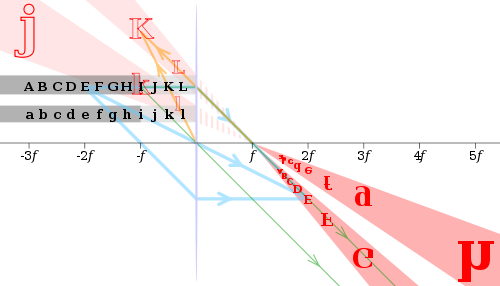
Incoming parallel rays are focused by a converging lens at a point one focal length from the lens, on the far side of the lens. This is called the rear focal point of the lens. Rays from an object at a finite distance are focused further from the lens than the focal length; the closer the object is to the lens, the further the image is from the lens.
With diverging lenses, incoming parallel rays diverge after passing through the lens in such a way that they appear to have originated from a point at a focal length in front of the lens. This is the front focal point of the lens. Rays from an object at a finite distance are associated with a virtual image that is closer to the lens than the focal point, and on the same side of the lens as the object. The closer the object is to the lens, the closer the virtual image is to the lens. As with mirrors, vertical images produced by a single lens are virtual, while inverted images are real.
Lens suffer from aberrations that distort images. Monochromatic aberrations occur because the geometry of the lens does not direct rays from every point on the object to a single point in the image, while chromatic aberration occurs because the refractive index of the lens varies with the wavelength of light.
Physical optics
In physical optics or wave optics, light is considered to propagate as a wave. This model predicts phenomena such as interference and diffraction, which are not explained by geometric optics. Waves propagate in the Earth's atmosphere at almost the same speed as light in a vacuum, at approximately 3.0×108 m/s (exactly 299,792,458 m/s in a vacuum). The wavelength of visible light waves ranges from 400 to 700 nanometers, but the word "light" is also often applied to infrared radiation (0.7-300 μm) and ultraviolet radiation (10−400 nm). The wave model can be used to make predictions about how an optical system will behave without requiring an explanation of what medium the waves are "wavering" over. Until the middle of the 19th century, most physicists believed in an "ethereal" medium in which light disturbance propagated The existence of electromagnetic waves was predicted in 1865 by Maxwell's equations. These waves propagate at the speed of light and manifest variable electric and magnetic fields that are orthogonal to each other, and also to the direction of propagation of the waves. Currently, light waves are treated as electromagnetic waves, except when they are must consider quantum mechanical effects.
Modeling and design of optical systems using physical optics
Many simplified approaches are available for analyzing and designing optical systems. Most use a single scalar quantity to represent the electric field of the light wave, rather than using a vector model with orthogonal electric and magnetic vectors.
The Fresnel-Huygens principle is one such model, empirically deduced by Fresnel in 1815, based on Huygens's hypothesis that each point on a wavefront generates a secondary spherical wavefront, which Fresnel combined with the wave superposition principle. Kirchhoff's diffraction formula, which follows from Maxwell's equations, places the Huygens-Fresnel equation on a firmer physical footing. Examples of the application of the Huygens-Fresnel principle can be found in the sections on diffraction and Fraunhofer diffraction.
More rigorous models, involving electric and magnetic field modeling of the light wave, are required when it comes to the detailed interaction of light with materials in which the interaction depends on their electrical and magnetic properties. For example, the behavior of a light wave interacting with a metal surface is quite different from what happens when it interacts with a dielectric material. A vector model must also be used to model polarized light.
Numerical simulation techniques, such as the finite element method, boundary element method, and linear transmission matrix method, can be used to model the propagation of light in systems that cannot be solved analytically. Such models are computationally demanding and are typically only used to solve small-scale problems that require greater precision than can be achieved with analytical solutions.
All the results of geometric optics can be reproduced using the techniques of Fourier optics, which apply many of the same mathematical and analytical techniques used in acoustic engineering and signal processing.
The Gaussian beam propagation is a simple paraxial physical optics model for dealing with the propagation of coherent radiation, such as laser beams. This technique partially accounts for diffraction, allowing precise calculations of the rate at which a laser beam expands with distance, and the minimum size to which the beam can be focused. Gaussian beam propagation bridges the gap between geometric optics and physics.
Overlapping and Interference
| Wave form combined |  | |
| Onda 1 | ||
| Onda 2 | ||
| Two waves phase | Two waves 180° | |
In the absence of non-linear effects, the superposition principle can be used to predict the configuration of interacting waveforms by simply adding disturbances. This interaction of waves to produce a resulting pattern is generally referred to as "interference". » and can result in a wide variety of results. If two waves of the same wavelength and frequency are in phase, the crests and troughs of the waves line up. This results in interference, with an increase in the amplitude of the wave, which for light is associated with a brightening of the waveform at that location. Alternatively, if the two waves of the same wavelength and frequency are out of phase, the wave crests will align with the troughs of each wave and vice versa. This results in interference with a decrease in wave amplitude, which for light is associated with a darkening of the waveform at that location. See below for an illustration of this effect.
As the Fresnel-Huygens Principle states that each point on a wavefront is associated with the production of a new disturbance, it is possible for a wavefront to constructively or destructively interfere at different locations, producing bright fringes and dark in regular, predictable patterns. Interferometry is the science of measuring these patterns, usually as a means of making precise determinations of distances or optical resolutions. The Michelson interferometer is a famous instrument that used interference effects to measure with precision the speed of light.
The appearance of thin films and coatings is directly affected by interference effects. Glare suppression uses destructive interference to reduce the reflectivity of the surfaces they cover, and can be used to minimize glare and unwanted reflections. The simplest case is a single layer with a thickness of a quarter of the wavelength of the incident light. The reflected wave from the top of the film and the reflected wave from the film/material interface are exactly 180° out of phase, causing destructive interference. The waves are only exactly out of phase for a given wavelength, which is typically chosen to be near the center of the visible spectrum, around 550 nm. More complex designs using multiple layers can achieve low reflectivity over a broad band or extremely low reflectivity over a single wavelength.
Constructive interference in thin films can create a strong reflection of light over a range of wavelengths, which can be narrow or wide depending on the coating design. These films are used to make dielectric mirrors, interference filters, heat reflectors, and filters for color separation in color television cameras. This interference effect is also what causes the colorful rainbow patterns seen in oil slicks and soap bubbles.
Diffraction and optical resolution

Diffraction is the process by which the interference of light is most commonly observed. The effect was first described in 1665 by Francesco Maria Grimaldi, who also coined the Latin term diffringere, meaning "to break into pieces". Later in the century, Robert Hooke and Isaac Newton they also described phenomena now known as Newton's ring diffraction, while James Gregory recorded his observations on the diffraction patterns of bird feathers.
The first model of diffraction using physical optics was based on the Fresnel-Huygens principle, and was developed in 1803 by Thomas Young through his double-slit experiment, analyzing the interference patterns of two closely spaced slits. He showed that his results could only be explained if the two slits acted as single wave sources rather than corpuscles.In 1815 and 1818, Augustin Fresnel firmly established the mathematics of how wave interference can explain diffraction.
The simplest physical models of diffraction use equations that describe the angular separation of light and dark fringes due to light of a particular wavelength (λ). In general, the equation takes the form
- mλ λ =dwithout θ θ {displaystyle mlambda =dsin theta }
where d{displaystyle d} is the separation between two wave front sources (in the case of Young's experiments, there were two slots), θ θ {displaystyle theta } is the angular separation between the central strip and the order strip mThat's it.{displaystyle m_{text{ésimo}}}where the central maximum is m=0{displaystyle m=0}.
This equation is slightly modified to account for a variety of situations such as diffraction through a single gap, diffraction through multiple slits, or diffraction through a grating containing a large number of slits. equally spaced slits. More complicated diffraction patterns require working with Fresnel or Fraunhofer mathematics.
X-ray crystalography makes use of the fact that atoms in a crystal have a regular space at distances that are in the order of an angstrom. To see defaction patterns, X-rays are passed with wavelengths similar to that spaced through the glass. Since crystals are three-dimensional objects instead of two-dimensional grids, the associated defaction pattern varies in two directions according to Bragg's law, and the associated bright points are produced in unique patterns and d{displaystyle d} is twice the space between atoms.
The effects of diffraction limit the sensitivity of an optical detector to the separation between two light sources, determining its optical resolution. In general, light passing through an aperture will experience diffraction, and the best images that can be created through this aperture (as described in a diffraction limited system) appear as a central point with surrounding bright rings, separated by dark stripes; this pattern is known as an Airy disk. The size of such a disk is given by
- without θ θ =1.22λ λ D{displaystyle sin theta =1.22{frac {lambda }{D}}
where θ is the angular resolution, λ is the wavelength of the light, and D is the diameter of the aperture of the aim. If the angular separation of the two points is significantly less than the angular radius of the Airy disk, then the two points cannot be resolved in the image, but if their angular separation is much greater than this, distinct images of the two are formed. points and therefore can be solved. Rayleigh defined "optical resolution" arbitrarily as the two points whose angular separation equals the radius of the Airy disk (measured to the first null ring, that is, to the first place where no light is seen) that can be considered resolved. It can be seen that the larger the diameter of the lens or its aperture, the finer the resolution. Astronomical interferometry, with its ability to emulate extremely large baseline apertures, allows for the highest possible angular resolution.
For astronomical images, the atmosphere prevents optimal resolution in the visible spectrum from being achieved due to atmospheric scattering that causes the stars to flicker. Astronomers refer to this effect as display quality. Techniques known as adaptive optics have been used to remove atmospheric disturbance from images and achieve results that approach the diffraction limit.
Scatter
Refraction processes take place at the limit of physical optics, where the wavelength of light is similar at other distances, as in a dispersion-type phenomenon. The simplest type of scattering is Thomson scattering, which occurs when electromagnetic waves are deflected by individual particles. In the limit of Thomson scattering, in which the wave nature of light is apparent, light is scattered regardless of frequency, in contrast to the Compton effect, which is frequency dependent and strictly a quantum mechanical process., which involves the nature of light as a beam of particles. In a statistical sense, the elastic scattering of light caused by numerous particles much smaller than the wavelength of light is a process known as Rayleigh scattering, while the similar process for scattering particles similar to or larger than the wavelength of wave is known as Mie diffusion with the Tyndall effect being a commonly observed result. A small proportion of the light scattering produced by atoms or molecules can undergo the Raman effect, where the frequency changes due to the excitation of the atoms and molecules. Brillouin scattering occurs when the frequency of light varies due to local changes with time and movements of a dense material.
Scattering occurs when different frequencies of light have different phase velocities, due to material properties (material scattering) or the geometry of an optical waveguide (scattering waveguide). The most familiar form of scattering is a decrease in refractive index with increasing wavelength, which is seen in most transparent materials. This is called "normal dispersion." It occurs in all dielectric materials, in wavelength ranges where the material does not absorb light. In wavelength ranges where a medium has significant absorption, the refractive index can increase with wavelength. This phenomenon is called "anomalous dispersion".
The separation of colors by a prism is an example of normal dispersion. On prism surfaces, Snell's law predicts that light incident at an angle θ to the normal is refracted at an angle equal to [arcsine(sin(θ)/n)]. Therefore, blue light, with its higher refractive index, is bent more strongly than red light, resulting in the well-known rainbow pattern.
The dispersion of a material is often characterized by the Abbe number, which provides a simple measure of dispersion based on the refractive index at three specific wavelengths. Wave conduction dispersion depends on the propagation constant. Both types of dispersion cause changes in the characteristics of the wave group and in the characteristics of the wave packet, which change with the same frequency as the amplitude of the wave itself. electromagnetic. The “group velocity spread” manifests itself as a spread of the radiation signal “envelope” and can be quantized with a group spread delay parameter:
- D=1vg2dvgdλ λ {displaystyle D={frac {1}{v_{g}}}{frac {dv_{g}}}{dlambda }}}}}{
where vg{displaystyle v_{g}} It's group speed. For a uniform medium, the speed of the group is
- vg=c(n− − λ λ dndλ λ )− − 1{displaystyle v_{g}=cleft(n-lambda {frac {dn}{dlambda }}right)^{-1}}
where n is the refractive index and c is the speed of light in a vacuum. This provides a simpler form for the retardation parameter of the dispersion:
- D=− − λ λ cd2ndλ λ 2.{displaystyle D=-{frac {lambda }{c}}{,{frac {d^{2}n}{dlambda ^{2}}}}}}}} !
If D is less than zero, the medium is said to have positive dispersion or normal dispersion. If D is greater than zero, the medium has negative dispersion. If a light pulse propagates through a normally dispersive medium, the result is that higher frequency components slow down more than lower frequency components. Thus, the pulse becomes positively pulsating, increasing in frequency with time. This causes the spectrum coming out of a prism to appear with the least refracted red light and the most refracted blue/violet light. Conversely, if a pulse travels through an anomalous (negative) dispersive medium, the high-frequency components travel faster than the low-frequency ones, and the pulse becomes "negatively pulsating", decreasing in frequency over time.
The result of the group velocity spread, either negative or positive, is the time spread of the pulse. This makes dispersion management extremely important in optical fiber-based communication systems, because if the dispersion is too high, a group of pulses encoding binary information will spread out in time and merge, which will make it impossible to extract the signal.
Polarization
| Lineal | Circular | Elliptical |
Polarization is a general property of waves that describes the orientation of their oscillations. For transverse waves, like many electromagnetic waves, it describes the orientation of the oscillations in the plane perpendicular to the direction of travel of the wave. The oscillations can be oriented in only one direction (linear polarization), or the direction of oscillation can rotate as the wave travels (circular or elliptical). Circularly polarized waves can rotate to the right or to the left relative to the direction of travel, and which of these two rotations is present in a wave is called the chirality of the wave.
The typical way to consider polarization is to keep track of the orientation of the electric field vector as the electromagnetic wave propagates. The electric field vector of a plane wave can be arbitrarily divided into two perpendicular components labeled x and y (with z indicating direction). of propagation). The shape projected onto the xy-plane by the electric field vector is a Lissajous figure describing the "polarization state". The figures above show some examples of the evolution of the electric field vector (blue), over time (the vertical axis), at a particular point in space, along with its x and y components (red/left and green/right), and the path traced by the In-Plane Vector (purple): The same evolution would occur if the electric field in the opposite direction of propagation at a particular moment is observed while the point is evolving in space.
In the figure above, the x and y components of the light wave are in phase. In this case, the ratio of their amplitudes is constant, so the direction of the electric vector (the vector sum of these two components) is constant. Since the tip of the vector traces a single line in the plane, this special case is called linear polarization. The direction of this line depends on the relative amplitudes of the two components.
In the central figure, the two orthogonal components have the same amplitudes and are 90° out of phase. In this case, one component is zero when the other component is at maximum or minimum amplitude. There are two possible phase relationships that satisfy this requirement: the x component can be 90° ahead of the y component, or it can be 90° behind the y component. . In this special case, the electric vector traces a circle in the plane, so this polarization is called circular polarization. The direction of rotation in the circle depends on which of the two phase relationships exists and correspond to "clockwise circular polarization" and "counterclockwise circular polarization".
In all other cases, when the two components do not have the same amplitudes and/or their phase difference is not zero or a multiple of 90°, the polarization is called elliptical polarization because the electric vector traces an ellipse in the plane (the ellipse of polarization). This is shown in the figure above to the right. The detailed mathematics of polarization uses the Jones calculus and is characterized by the Stokes parameters.
Polarization Shift
Media that have different refractive indices for different modes of polarization are called birefringent. Well-known manifestations of this effect appear in wavesheets/optical retarders (linear modes) and in the effect Faraday/optical activity (circular modes). If the path length in the birefringent medium is sufficient, planar polarization waves will exit the material with a significantly different direction of propagation, due to refraction. For example, this is the case with macroscopic calcite crystals, which present the viewer with two displaced, orthogonally polarized images of what is seen through them. It was this effect that provided the first discovery of a polarization phenomenon by Rasmus Bartholin in 1669. Furthermore, the phase shift, and therefore the change in state of polarization, generally depends on frequency, which, in combination with dichroism often results in brilliant colors and rainbow-like effects. In mineralogy, these properties, known as pleochroism, are frequently exploited in order to identify minerals using polarized light microscopes. In addition, many plastics that are not normally birefringent become so when subjected to mechanical stress, a phenomenon that is the basis of photoelasticity methods. To rotate the linear polarization of light beams, in addition to the rotary polarizer, there are binoculars. which use the total internal reflection in a set of prisms designed to obtain efficient collinear transmission.
Media that reduce the amplitude of certain modes of polarization are called dichroic, with devices that block almost all radiation in devices known as polarizing filters or simply polarizers. Malus' law, named after Étienne-Louis Malus, says that when a perfect polarizer is placed in a linearly polarized beam of light, the intensity, I, of the light passing through it is given by
- I=I0#2 θ θ i{displaystyle I=I_{0}cos ^{2}theta _{i}quad }
where
- I0 is the initial intensity, and
- θi is the angle between the initial polarization direction of the light and the axis of the polarizer.
It may be thought that an unpolluted beam contains a uniform mix of linear polarizations in all possible angles. Since the average value of #2 θ θ {displaystyle cos ^{2}theta } is 1/2, the transmission coefficient becomes
- II0=12{displaystyle {frac {I}{I_{0}}}}={frac {1{2}}}{quad }
In practice, some light is lost in the polarizer and the actual transmission of unpolarized light will be somewhat less, around 38% for Polaroid-type polarizers but considerably higher (>49.9%) for some types of birefringent prisms.
In addition to birefringence and dichroism in extensive media, polarization effects can also occur at the (reflective) interface between two materials of different refractive index. These effects are dealt with by the Fresnel equations. Part of the wave is transmitted and part is reflected, and the relationship depends on the angle of incidence and the angle of refraction. In this way, physical optics is related to wave physics through the parameter called: Brewster angle. When light is reflected from a thin film on a surface, interference between reflections from the film surfaces can produce polarization in reflected and transmitted light.
Daylight
Most sources of electromagnetic radiation contain a large number of atoms or molecules that emit light. The orientation of the electric fields produced by these emitters may be uncorrelated, in which case the light is said to be "unpolarized." If there is a partial correlation between the emitters, the light is "partially polarized." If the polarization is constant throughout the spectrum of the source, partially polarized light can be described as a superposition of a fully unpolarized and a fully polarized component. Light can be described in terms of its degree of polarization and according to the parameters of the ellipse of polarization.
When reflected by transparent, shiny materials, it is partially or fully polarized, except if the light is normal (perpendicular) to the surface. It was this effect that allowed the mathematician Étienne-Louis Malus to make the measurements that led to the development of the first mathematical models of polarized light. Polarization occurs when light is scattered in the Earth's atmosphere. Scattered light produces the brightness and color of the clear sky. This partial polarization of the scattered light can be exploited by using polarizing filters to darken the sky in certain photographs. Optical polarization is primarily important in chemistry, due to the circular dichroism and optical activity ("circular birefringence") exhibited by optically active chiral molecules.
Modern optics
Modern optics encompasses areas of optical science and engineering that became popular in the century. XX. These areas of optical science are typically concerned with the electromagnetic or quantum properties of light, but include other topics. An important subfield of modern optics, quantum optics, deals specifically with the quantum mechanical properties of light. Quantum optics is not just theoretical; some modern devices, such as lasers, have principles of operation that are described by quantum mechanics. Light detectors, such as photomultipliers and gutters, respond to single photons. Electronic image sensors, such as CCDs, exhibit shot noise corresponding to the statistics of single photon events. LEDs and photoelectric cells cannot be understood without quantum mechanics either. In the study of these devices, quantum electronics often overlaps with quantum optics.
Optical research specialty areas include the study of how light interacts with specific materials such as crystal optics and metamaterials. Another line of research focuses on the phenomena associated with electromagnetic waves such as optical singularities, non-image optics, nonlinear optics, statistical optics and radiometry. In addition, computer engineering has been interested in integrated optics, machine vision, and optical computers as possible components of the "next generation" of computers.
Today, the pure science of optics is called optical science or optical physics to distinguish it from the applied optical sciences, which are known as optical engineering. Notable subfields of optical engineering include lighting engineering, photonics, and optoelectronics, with practical applications such as optical lens design, optical component manufacturing and testing, and digital image processing. Some of these fields overlap, with hazy boundaries between the terms describing the respective disciplines, which mean slightly different things in different parts of the world and in different areas of industry. A professional community of researchers in nonlinear optics has developed in recent decades, thanks to advances in laser technology.
Laser
A laser is a device that emits light (electromagnetic radiation) through a process called: stimulated emission. The term laser is an acronym for Light Amplification by Stimulated Emission of Radiation. Laser light is generally coherent, which means that it is emitted in a narrow, low-divergence beam or can be converted to one of these beams with the help of optical components such as lenses. Because the microwave equivalent of the laser, the 'maser', was developed first, devices that emit microwave and radio frequencies are generally called 'masers'.
The first working laser was introduced on May 16, 1960 by Theodore Harold Maiman at Hughes Research Laboratories. When they were first invented, they were called "a solution looking for a problem". Since then, lasers have become a multi-billion dollar industry, finding utility in thousands of widely varying applications. The first visible laser application in everyday life for the general population was the supermarket barcode scanner, introduced in 1974. The laserdisc player, introduced in 1978, was the first successful consumer product to include a laser, but the compact disc player was the first truly common laser-equipped device in consumer homes, beginning in 1982. These optical storage devices use a laser diode less than one millimeter wide with which they scan the surface of the disk for data recovery. Fiber optic communications rely on lasers to transmit large amounts of information at the speed of light. Other common applications for lasers include laser printers and laser pointers. They are also used in medicine in areas such as general surgery, refractive surgery, and laser microdissection; as well as in military applications such as anti-missile systems, electro-optical countermeasures and lIDAR systems. Lasers are also used in holography, 3D engraving, laser displays, and laser hair removal.
In construction, they are used as cutting tools for sheet metal; In geodesy and topography, laser rangefinders are used for the precise measurement of distances (as in the extreme case of measuring the distance between the Earth and the Moon, using the mirrors located on the surface of the satellite by different space missions); and in aeronautical navigation they are the basis of ring laser gyroscopes.
Likewise, in some types of nuclear fusion reactors, high-power laser beams are used to reach the high temperatures required for this type of reaction.
Kapitsa–Dirac effect
The Kapitsa-Dirac effect causes particle beams to diffract as a result of encountering a standing wave of light. Light can be used to manipulate atomic or molecular fragments of matter, taking advantage of the properties of this phenomenon (see optical tweezers).
Applications
Optics are part of everyday life. The ubiquity of visual systems in biology indicates the central role optics plays as a science of one of the five senses. Many people benefit from glasses or contact lenses, and optics are essential to the operation of many consumer goods, including still, film, and television cameras. Rainbows and mirages are examples of optical phenomena. Fiber optics provide the backbone for both the Internet and modern telephony.
Human eye
The human eye works by focusing light onto a layer of photoreceptors called the retina, which forms the inner lining of the back of the eye. Focus is achieved through a series of transparent means. Light entering the eye first passes through the cornea, which provides much of the eye's optical power. It then continues through the fluid contained just behind the cornea, in the anterior chamber, and through the pupil. It then passes through the lens, which further focuses light and allows focus adjustment, and passes through the main body of fluid within the eye, the vitreous humor, and reaches the retina. Photosensitive cells in the retina line the back of the eye, except where the optic nerve exits; this results in a blind spot.
There are two types of photoreceptor cells, rods and cones, which are sensitive to different aspects of light. Cells Cones are sensitive to light intensity over a wide frequency range, therefore they are responsible for black and white vision. The rods are not present in the fovea, the area of the retina responsible for central vision, and are not as sensitive as the cones to spatial and temporal changes in light. However, there are twenty times as many rods as there are cones in the retina, because the former are present over a larger area. Due to their broader distribution, the rods are responsible for peripheral vision.
By contrast, cones are less sensitive to overall light intensity, but come in three varieties that are sensitive to different frequency ranges and are therefore used in color perception and in vision. photopic vision. Cone cells are highly concentrated in the fovea and have high visual acuity, meaning they are better at spatial resolution than rod cells. Since the cones are not as sensitive to dim light as the rods, most night vision is limited to the rods. Similarly, because the cones are located in the fovea, central vision (including the vision needed to perform most fine-detail tasks, such as reading, sewing, or carefully examining objects) is provided by the cones. cone cells.
The ciliary muscles around the lens help adjust the focus of the eye. This process is known as accommodation. Presbyopia and far point define the closest and furthest distances to the eye at which an object can be brought into sharp focus. For a person with normal vision, the far point is at infinity. The location of the near point depends on how much the muscles can increase the curvature of the lens and its loss of flexibility with age. Optometrists, ophthalmologists, and opticians generally consider an appropriate near point to be closer than the normal reading distance, approximately 10 inches.
Vision defects can be explained using optical principles. As people age, the lens becomes less flexible and the near point moves away from the eye, a condition known as presbyopia. Similarly, people who are farsighted cannot decrease the focal length of their lens enough to allow close objects to be seen on their retina. Conversely, myopia occurs when the far point is considerably closer than infinity. A problem known as astigmatism occurs when the cornea is not spherical, but is more curved in a certain direction. This causes horizontally stretched objects to focus on the retina differently than vertically stretched objects, and results in distorted images.
All of these functional deficiencies can be corrected with corrective lenses. For presbyopia and farsightedness, a lens brings the near point closer to the eye, while for myopia, it sends the far point to infinity. Astigmatism is corrected with a lens with a cylindrical surface that curves more strongly in one direction than another, compensating for the non-uniformity of the cornea.
The optical power of corrective lenses is measured in diopters, a value equal to the inverse of the focal length measured in meters. A positive focal length corresponds to a converging lens and a negative focal length corresponds to a diverging one. For lenses that also correct for astigmatism, three numbers are given: one for the spherical power, one for the cylindrical power, and the third for the angle of orientation of the astigmatism.
Visual effects
Optical illusions (also called visual illusions) are characterized by visually perceived images that differ from objective reality. The information collected by the eyes is processed in the brain to give a perception that differs from the object being observed. Optical illusions can be the result of a variety of phenomena, including physical effects that create images that are different from the objects that produce them, physiological effects on the eyes and brain of excessive stimulation (for example, glare, tilt, etc.), color, or motion) and cognitive illusions in which the eye and brain produce subconscious inferences.
Cognitive illusions include some that result from the unconscious misapplication of certain optical principles. For example, effects such as the Ames room, the Hering illusion, those of Müller-Lyer, Orbison, Ponzo, Sander and de Wundt, are based on creating the sensation of distance through the use of converging and diverging lines, in the same way. so that parallel light rays (or indeed any set of parallel lines) appear to converge on a vanishing point on the horizon when rendering two-dimensional perspective. This suggestion is also responsible for the famous lunar illusion, in which the moon, despite having essentially the same angular diameter, appears much larger near the horizon than at the zenith. This illusion confused Ptolemy, who incorrectly attributed it to refraction atmosphere when he described it in his treatise on optics.
Another type of optical illusion exploits broken patterns to trick the mind into perceiving symmetries or asymmetries that are not actually present. Examples include the Cafeteria Wall, Ehrenstein, Fraser Spiral, Poggendorff illusions and the Zöllner illusion. Related to, but not strictly illusions, are the patterns produced by the superposition of periodic structures. For example, sheer fabrics with a grid structure produce shapes known as a Moiré pattern, while overlapping periodic sheer patterns comprising parallel opaque lines or curves produce linear Moiré patterns.
Optical instruments
Single lenses have a wide variety of applications including photographic lenses, corrective lenses, and loupes, while single mirrors are used in parabolic reflectors and rear view mirrors. The combination of various mirrors, prisms, and lenses produces compound optical instruments that have a variety of practical uses. For example, a periscope is simply made up of two flat mirrors aligned to allow seeing around an obstacle. The most famous compound optical instruments in science are the microscope and the telescope, which were devised by the Dutch in the late 16th century.
Microscopes were first developed with just two lenses: an objective and an eyepiece. The objective lens is essentially a magnifying glass, and was designed with a very small focal length, while the eyepiece generally has a longer focal length. This has the effect of producing magnified images of nearby objects. In general, an additional light source is used, since enlarged images are weaker due to the principle of conservation of energy and the scattering of light rays over a larger surface area. Modern microscopes, known as compound microscopes have many lenses (usually four) to optimize functionality and improve image stability. A slightly different variety of microscope, the stereo microscope, allows two images to be obtained. of the samples examined, which are perceived in three dimensions thanks to the use of a binocular system.
Early telescopes, so-called refracting telescopes, were also developed with a single objective and eyepiece lens. In contrast to the microscope, the telescope objective lens was designed with a long focal length to avoid optical aberrations. The objective focuses an image of a distant object at its focal point, which is adjusted to locate itself at the focal point of an eyepiece with a much smaller focal length. The primary objective of a telescope is not necessarily magnification, but rather light collection, which is determined by the physical size of the objective lens. Therefore, telescopes are normally named by the diameters of their objectives rather than by the magnification that can be obtained by changing the eyepieces. Because the magnification of a telescope is equal to the focal length of the objective divided by the focal length of the eyepiece, smaller focal length eyepieces produce a higher magnification.
Since making large lenses is much more difficult than making large mirrors, most modern telescopes are reflecting telescopes, that is, telescopes that use a primary mirror instead of an objective. The same general optical considerations that apply to reflecting telescopes apply to refracting telescopes, namely that the larger the primary mirror, the more light is collected, and the magnification equals the primary mirror focal length divided by the focal length of the eyepiece. Professional telescopes generally do not have eyepieces and instead an electronic imaging system (often a charge-coupled device) is attached to the focal point.
Photography
The optics of photography involves both the use of lenses and the medium in which electromagnetic radiation is recorded, be it a plate, film, or charge-coupled device. Photographers must consider the reciprocal relationship between the camera and the shot, which is summarized by the equality
- Effective Exhibition = Opening Area x Exposure Time x Scene Luminance
In other words, the smaller the aperture (providing a greater depth of focus), the less light will enter, so the exposure time will need to be increased (which can cause a blurry image if it occurs). motion). An example of the use of the law of reciprocity is the 16/f rule, which provides a rough reference for the settings needed to estimate adequate daytime exposure.
The opening of a camera is measured with a number without units called "f", f/#, often scored as N{displaystyle N}and given by
- f/# # =N=fD{displaystyle f/#=N={frac {f}{d}{d}{d}}{d}}{d}}}}
where f{displaystyle f} is the focal distance and D{displaystyle D} is the diameter of the hole of the entrance diaphragm. By convention, "f/#" is treated as a unique symbol, and the specific f/# values are written replacing the pad with a numerical value. The two ways to increase the limit of the focal point are to decrease the diameter of the shutter or change to a longer focal distance (in the case of a zum, this can be done simply by adjusting the lens). The higher f numbers also have a greater depth of field because the target approaches the limit of a snopeic camera that can focus all images perfectly, regardless of distance, but requires very long exposure times.
The field of view that the lens will provide changes with the focal length of the lens. There are three basic classifications based on the relationship to the diagonal size of the film or the size of the camera sensor to the focal length of the lens:
- Normal objective: vision angle of approximately 50° (called "normal" because this angle is considered to be approximately equivalent to human vision) and a focal distance approximately equal to the diagonal of the film or sensor.
- Wide angular lens: wider viewing angle than 60° and shorter focal distance than a normal lens.
- Long focus goal: narrower vision angle than a normal lens. This is a lens with a focal length longer than the diagonal measurement of the film or sensor. The most common type of long-focus lens is the telephoto lens, a design that uses a special "TV" to be physically shorter than its focal distance.
Modern zooms may have some or all of these attributes.
The absolute value for the exposure time required depends on the light sensitivity of the medium used (as measured by a photographic sensitivity scale or, for digital media, by its quantum efficiency). Early photographs used media that had very little light sensitivity, and therefore exposure times had to be long, even for very bright shots. As technology has improved, so has sensitivity with the development of increasingly versatile film and better-performing digital cameras.
Other results from physical and geometric optics apply to camera optics. For example, the maximum resolution capability of a particular camera setup is determined by the diffraction limit associated with the size of the shutter and, roughly, by the Rayleigh criterion.
Atmospheric optics
The unique optical properties of the atmosphere cause a wide range of spectacular optical phenomena. The blue color of the sky is a direct result of Rayleigh scattering redirecting higher frequency (blue) sunlight into the observer's field of view. Because blue light is more easily scattered than red light, the sun takes on a reddish hue when viewed through a thick atmosphere, such as during sunrise or sunset. Particles suspended in the sky can scatter different colors at different angles creating brightly colored skies at dusk and dawn. The scattering of ice crystals and other particles in the atmosphere is responsible for halos, blushes, coronas, crepuscular rays, and sunshades. The variation in this type of phenomena is due to the different sizes and geometries of the particles.
Mirages are optical phenomena in which light rays are bent due to thermal variations that modify the refractive index of the air, producing displaced or highly distorted images of distant objects. Other spectacular optical phenomena associated with this effect include the Novaya Zemlya effect where the sun appears to rise ahead of schedule with a distorted shape. Another striking form of refraction that occurs under thermal inversion conditions is the phenomenon called Fata Morgana, in which objects on the horizon or even beyond the horizon, such as islands, cliffs, ships, or icebergs, appear elongated and raised, like "fairy tale castles".
Rainbows are the result of a combination of internal reflection and dispersive refraction of light in raindrops. A single reflection off the back of a series of raindrops produces a rainbow with an angular size in the sky ranging from 40° to 42°, with the color red on the outside. The two types of double rainbows are produced by two internal reflections with an angular size of 50.5° to 54°, with the violet color on the outside. Because rainbows are seen with the sun 180° from the center of the rainbow, they are more prominent the closer the sun is to the horizon.
Related reading
- Max Born, Emil Wolf (1991). Principles of Optics. Pergamon Press Ltd. 0-08-026481-6.
- Born, Max; Wolf, Emil (2002). Principles of Optics. Cambridge University Press. ISBN 1-139-64340-1.
- Hecht, Eugene (2002). Optics (4 edition). Addison-Wesley Longman, Incorporated. ISBN 0-8053-8566-5.
- Serway, Raymond A.; Jewett, John W. (2004). Physics for scientists and engineers (6, illustrated edition). Belmont, CA: Thomson-Brooks/Cole. ISBN 0-534-40842-7.
- Tipler, Paul A.; Mosca, Gene (2004). Physics for Scientists and Engineers: Electricity, Magnetism, Light, and Elementary Modern Physics 2. W. H. Freeman. ISBN 978-0-7167-0810-0.
- Lipson, Stephen G.; Lipson, Henry; Tannhauser, David Stefan (1995). Optical Physics. Cambridge University Press. ISBN 0-521-43631-1.
- Fowles, Grant R. (1975). Introduction to Modern Optics. Courier Dover Publications. ISBN 0-486-65957-7.
- Optical and photonic: physics improves our lives by Institute of Physics Publications
- Light and Matter - an open-source textbook, which contains an optical treatment in the cap. 28-32
- Optics2001 - Optical Library and Community
- Fundamental Optics - Technical Guide to Melles Griot
- Light and optical physics - Brigham Young University Undergraduate book
Contenido relacionado
Pendulum clock
Mach number
Force
